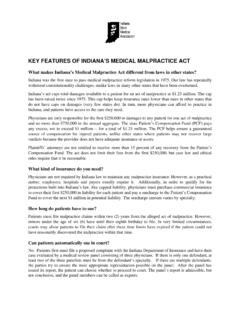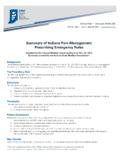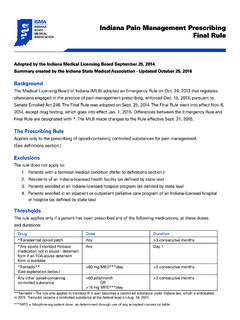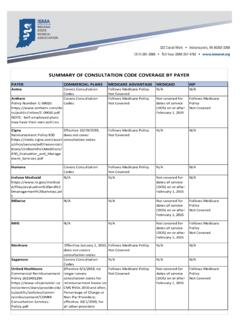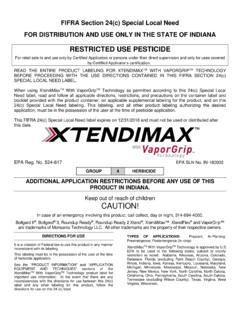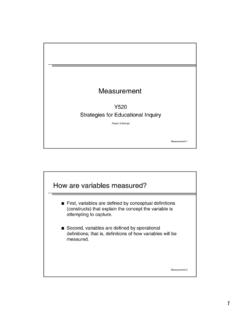Transcription of Indiana Pain Management Prescribing Final Rule
1 Adopted by the Indiana Medical Licensing Board September 25, 2014 Summary created by the Indiana State Medical Association - Updated October 25, 2016 Background The Medical Licensing Board of Indiana (MLB) adopted an Emergency Rule on Oct. 24, 2013 that regulates physicians engaged in the practice of pain Management Prescribing , enforced Dec. 15, 2013, pursuant to Senate Enrolled Act 246. The Final Rule was adopted on Sept. 25, 2014. The Final Rule went into effect Nov. 6, 2014, except drug testing, which goes into effect Jan. 1, 2015. Differences between the Emergency Rule and Final Rule are designated with *.
2 The MLB made changes to the Rule effective Sept. 21, Prescribing RuleApplies only to the Prescribing of opioid-containing controlled substances for pain Management . (See definitions section.)ExclusionsThe rule does not apply to:1. Patients with a terminal medical condition (Refer to definitions section.)2. Residents of an Indiana -licensed health facility (as defined by state law)3. Patients enrolled in an Indiana -licensed hospice program (as defined by state law)4. Patients enrolled in an inpatient or outpatient palliative care program of an Indiana -licensed hospital or hospice (as defined by state law)ThresholdsThe rule applies only if a patient has been prescribed any of the following medications, at these doses and durations: DrugDoseDuration*Transdermal opioid patchAny>3 consecutive months*Any opiate Extended Release medication not in abuse - deterrent form if an FDA-abuse deterrent form is availableAnyDay 1*Tramadol** (See explanation below.)
3 >60 mg MED**/day>3 consecutive monthsAny other opioid-containing controlled substance>60 pills/month OR>15 mg MED**/day>3 consecutive months**Tramadol The rule only applies to tramadol IF it ever becomes a controlled substance under Indiana law, which is anticipated in 2015. Tramadol became a controlled substance at the federal level on Aug. 18, 2014.**MED = Morphine-equivalent dose, as determined through use of any accepted conversion pain Management Prescribing Final RulePatient AssessmentPhysicians must perform their own initial evaluations and risk stratifications of patients, including:1.
4 Appropriately focused H&P exams and appropriate tests, as indicated2. Documented attempts to obtain and review records from prior providers3. Patient-completed pain assessment tools4. Assessment of patient s mental health status and risk for substance abuse with valid screening tools5. After initial evaluation, establishment a working diagnosis and tailored treatment plan to meaningful and functional goals. (Review the plan with the patient occasionally.) Non-OpioidsWhere medically appropriate, the physician must utilize non-opioid options instead of Prescribing Informed ConsentDiscuss with the patient: Potential risks and benefits of opioid treatment for chronic pain , including the rises and benefit of using an abuse deterrent form (as opposed to a non-abuse deterrent if an abuse-deterrent form is available for the opioid product prescribed to the patient.)
5 Expectations related to prescription requests Proper medication use Alternative modalities to opioids for managing pain A simple and clear explanation to help patients understand the key elements of their treatment plan Counseling for women ages 14 to 55 of child-bearing potential about risk to fetus when a mother has taken chronic opioids during pregnancy (including risk of fetal opioid dependency and neonatal abstinence syndrome) Risks of dependency and addiction *Safe storage practices for prescribed opioids*Provide a written warning disclosing the risks associated with taking extended-release medications that are not in an abuse deterrent form (if prescribed)
6 Patient Visits No Prescribing without periodic scheduled visits If medication and treatment plan are stable, face-to-face visits at least once every four months If changes are still being made to medication and treatment plan, visits at least every two months until stabilized During visits, evaluation of progress and compliance with treatment plan regularly and setting of clear expectations along the way ( , physical therapy, counseling, other treatment)INSPECT ReportsAt the outset of the treatment plan, and at least annually thereafter, Prescribing physician must run an INSPECT report and document in patient s chart whether it is consistent with the physician s knowledge of the patient s controlled substance use history.
7 Drug Monitoring Tests (Effective Jan. 1, 2015)*At any time the physician determines that it is medically necessary, whether at the outset of the treatment plan, or any time thereafter, a Prescribing physician shall perform or order a drug monitoring test that must include a confirmatory test using a method selective enough to differentiate individual drugs within a drug class.*In determining the medical necessity of a drug monitoring test, the physician shall consider these factors where applicable and reasonably feasible:1. Whether there is reason to believe a patient is not taking or is diverting the opioids prescribed2.
8 Whether there has been no appreciable impact on the chronic pain despite being prescribed for a period of time that would generally have an impact3. Whether there is reason to believe the patient is taking or using controlled substances other than opioids or other drugs or medications including illicit street drugs that might produce significant polypharmacological effects or have other detrimental interaction effects4. Whether there is reason to believe patient is taking or using additional opioids not prescribed by any treating physician5. Attempts by patient to obtain early refills of opioid-containing prescriptions6.
9 Number of instances when patients allege their prescriptions were lost or stolen7. INSPECT report provides irregular or inconsistent information8. Previous drug monitoring tests raised concerns about opioid usage9. Necessity of verifying the patient no long has substances in their system that are not appropriate under the treatment plan10. Patient engages in apparent aberrant behavior or shows apparent intoxication11. Patient s opioid usage shows an unauthorized dose escalation12. Patient is reluctant to change medications or is demanding certain medications13. Patient refuses to participate in or cooperate with a full diagnostic work-up or examination14.
10 Whether a patient has a history of substance abuse15. Patient has a health status change ( , pregnancy)16. Co-morbid psychiatric diagnoses17. Other evidence of chronic opioid use, controlled substance abuse or misuse, illegal drug use or addiction, or medication non-compliance18. Any other factor the physician believes is relevant to making an informed professional judgment about the medical necessity of a prescription*Physicians are required to consider all of the factors in determining whether to order/perform a drug test. However, once a physician determines that a drug test is medically necessary, any remaining factors (of the 18) that have not yet been considered do not have to be considered.
